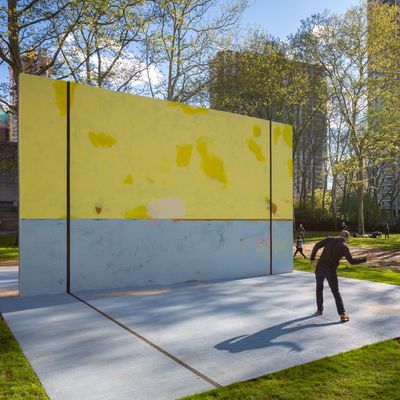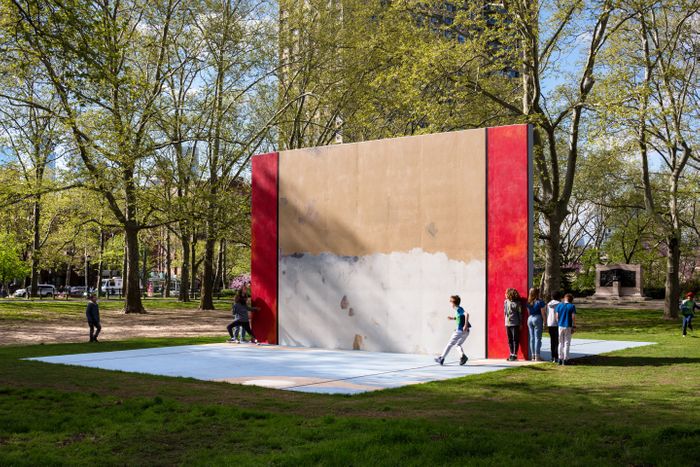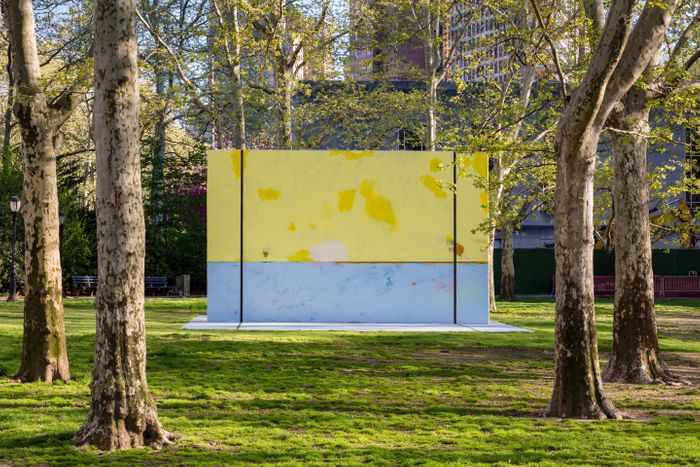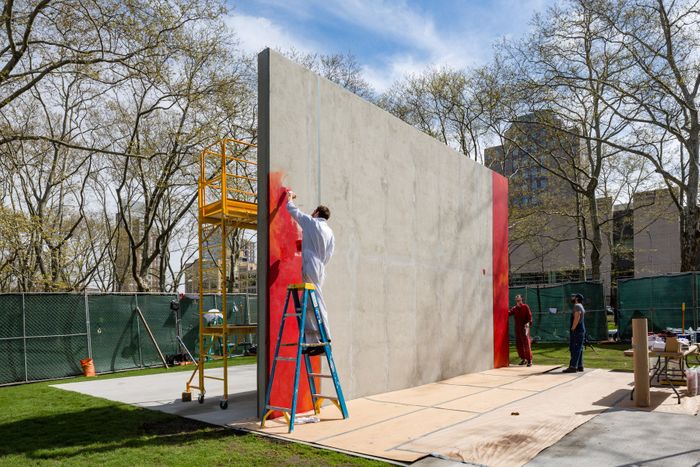
There are, according to the city Parks Department, 649 handball courts scattered throughout Brooklyn, but only one of them, in Cadman Plaza, is intentionally a work of art. It’s fully functional, but don’t despair if you lack the hand-eye coordination to play on it. “I just want it to be open to any possible interpretations,” said Harold Ancart, who created Subliminal Standard with the help of the Public Art Fund, standing at the fringe of his court with a cup of Starbucks coffee. “Any action will ultimately have meaning because people will interpret it one way or another. So you don’t have to load whatever the fuck you do with meaning.”
When Ancart, who grew up in Brussels, moved to Brooklyn in 2007, he noticed that the concrete walls of the many handball courts became accidental paintings after being touched up to mask graffiti and weathering. With Subliminal, Ancart encourages the public to notice these invisible artworks wherever they appear in our lives: in the clouds, clumps of dirt, or the decay of a wall along the highway.
“When you start looking around you notice all these patterns and things that are present everywhere, it becomes endless,” said Ancart.
The “subliminal” in the title references how these inadvertent artworks often exist below our level of consciousness, and also, the way in which the colorful structure that exists in nature evokes the sublime. The court sits among large London plane trees, whose yellow-green leaves blend spectacularly with the canary-yellow paint on one side of the wall.
“Standard” alludes to the more formal conventions of the handball court. At 16 feet tall and 20 feet wide, the freestanding, double-sided wall has the dimensions of a regulation court. The base of the structure, however, where the players typically zigzag and try to swat the ball, is slightly shorter than usual. That, combined with the fact that the wall isn’t surrounded by ball-stopping fences like most courts, might make it tricky to play a serious game.
That the public can engage so rigorously — whether running along the base or smacking a ball against the wall — makes Subliminal unique. But the accessibility of the work also leaves it vulnerable. Imagine, for instance, that someone decides to graffiti the wall. It would be fitting, in a sense, since the work is based on the abstract compositions that emerge after a court has been defaced. Daniel S. Palmer, who curated Subliminal, is wary of the work becoming a “performance piece” for Ancart, who will return to repaint the wall should it get scuffed, graffitied, or otherwise vandalized.
“If worst-case scenario, somebody does graffiti this wall, first of all they should know that they’re defacing a very beautiful and important painting,” said Palmer. “It certainly will not be tolerated or permitted.”
Ancart, on the other hand, wouldn’t be offended if someone defaced his artwork. It just might involve slapping a bit more paint over the top.
“I wouldn’t mind, you know? It wouldn’t be the end of the world to come to the park with a bucket of paint and just roll up the work,” said Ancart, adding that the work would stay in evolution. “I think it actually might become even more and more interesting.”
When Ancart was growing up in Brussels, around the age of 10, he played handball with his American friend Christoph Bell. They thwacked a tennis ball off a wall, whether it was the façade of a school building or parking garage, with a childlike disregard for the boundaries of the court. Nearly 30 years later and more than 3,500 miles away, Ancart now has his own court.
The game of handball has roots in ancient Rome and was later refined in Ireland. In 1886, the first American walled court sprung up in — quite fittingly — Brooklyn. Played with nothing more than a small black rubber ball, players take turns using their hands to smash the ball off a wall, combining power and direction to send the ball beyond their opponents’ reach.
Subliminal Standard will be on display — and ready for play — at Cadman Plaza Park, in Brooklyn through March 1, 2020.




